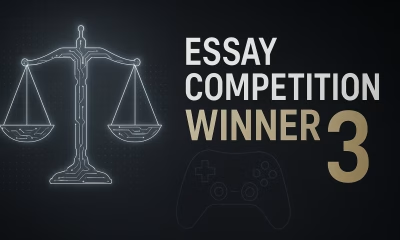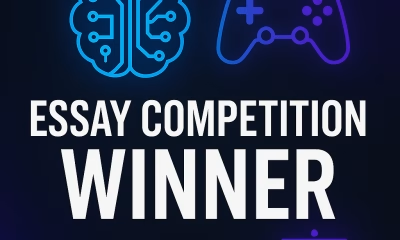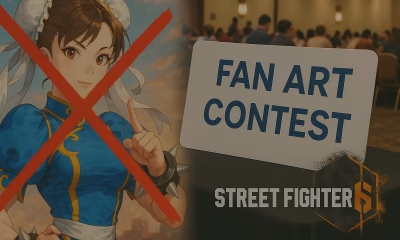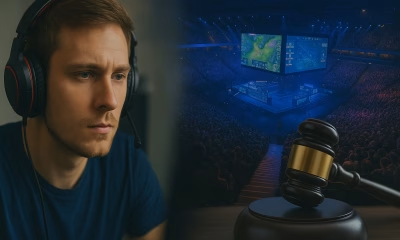IP
Esports Legal News Essay Competition Winner #2: Intellectual Property and User Rights in Video Games and Esports : A Normative Quest
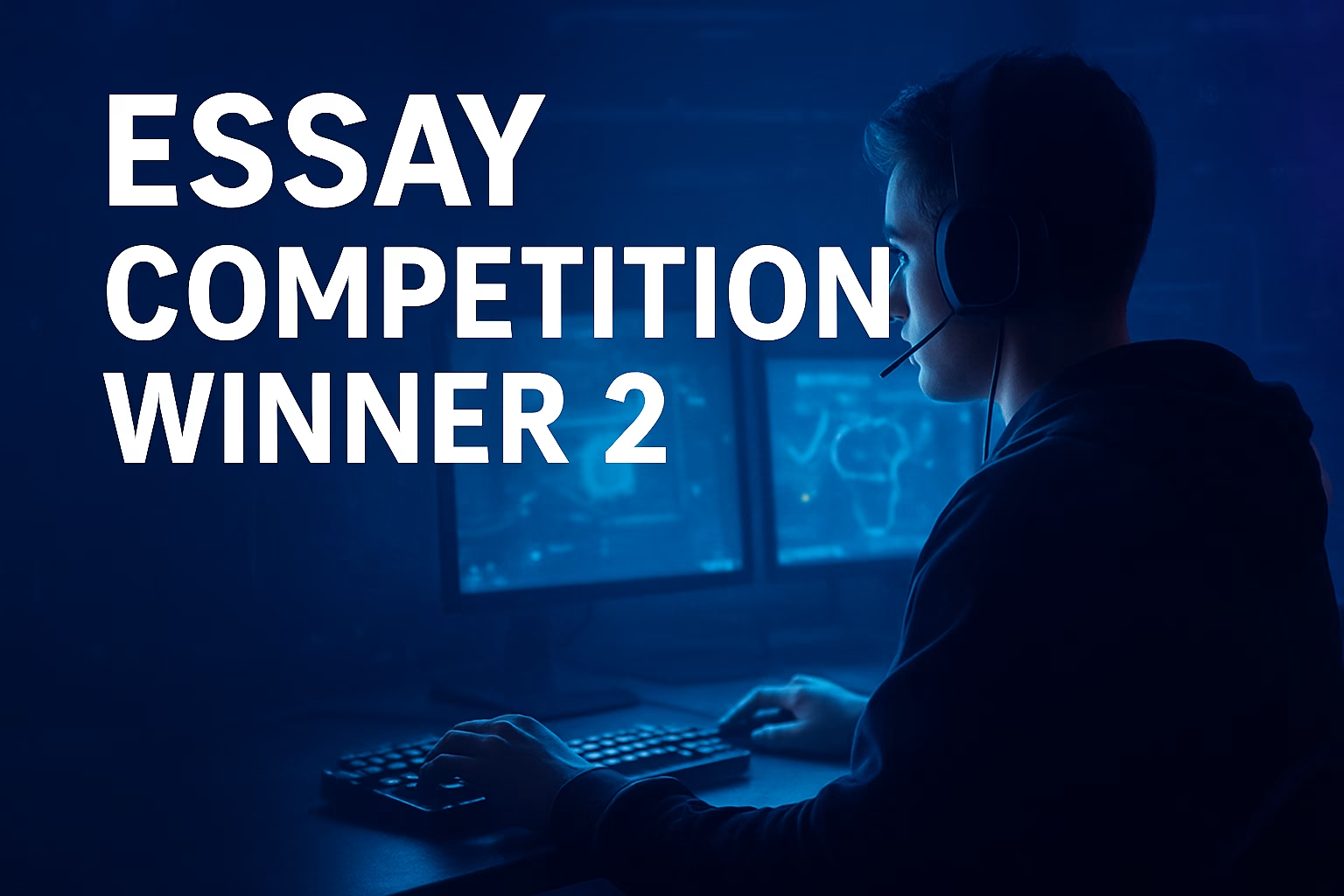
Table of Contents
We’re delighted to continue our series showcasing the winning essays from the Esports Legal News Essay Competition.
This week, we present the second winning essay, ‘Intellectual Property and User Rights in Video Games and Esports: A Normative Quest‘ by Dhritiraj Paul Choudhury and Madhabendu Chakraborty.
The piece explores how intellectual property frameworks intersect with the fast-evolving world of esports and gaming, raising key questions about ownership, creativity, and player rights. It’s a thought-provoking contribution to the ongoing dialogue at the crossroads of law, technology, and interactive entertainment. Enjoy!
Introduction : Growth of Video Games and the Rights Debate
Video games have evolved from a simple form of entertainment into a multi-billion dollar industry that includes vibrant online communities and esports scene. As this medium has grown, so too have legal questions about who should own and control the content and experiences within games. Game publishers rely on intellectual property (IP) rights and End-User License Agreements (EULAs) to protect their creations and revenue streams.
At the same time, gamers and content creators increasingly contribute their own labour and creativity, ranging from designing modifications and user-generated content to investing time and money in virtual goods and competitive play. This has led to tension between publishers’ rights and user rights, raising concerns about fairness, creativity and innovation in the gaming ecosystem.
This paper will explore the intersection of IP law, EULAs and user rights in video games and esports, with a focus on Indian law. It will offer doctrinal analysis of topics such as user-generated content, ownership of virtual goods, the enforceability of one-sided EULAs in esports and gaming sphere. Finally we will ask whether the current balance of rights truly serves the best interests of both creators and the public.
Intellectual Property in Video Games: Legal Foundations and Indian Context
Modern video games are complex forms of creative expressions encompassing graphics, music, storylines and even cinematic elements. All of these elements are usually protected as intellectual property in all jurisdictions across the world, including India.
Under Indian law, which is also aligned with international norms like the TRIPS Agreement[1], copyright subsists in original literary, artistic, musical and cinematographic works.
From a Copyright law perspective video games may be categorised as a computer software (literary work) or as a combination of multiple underlying works (literary, musical, artistic works). A game under Indian copyright law, for example holds an ambiguous status as a whole but it consists of independently copyrightable components. This means that each creative work underlying the game (the artwork, character models, maps, audio, storyline, etc.) enjoys copyright protection individually.
In India, the game’s software (code) may be protected as a literary work, while visual and audio assets are protected as artistic and musical works respectively.
The game’s software may also meet the threshold for patent protection, although the same is less likely because the threshold for a software to qualify for patent protection is usually very high and most software programs don’t qualify it. India, for instance require a software code to have a “technological/technical advancement.”[2]
Apart from copyright and patents, other IP rights can arise in gaming. Trademarks protect game titles, logos and character names used as brands. Trade secrets may also protect various aspects of the gaming ecosystem, including confidential information, sensitive data, technical know-hows etc.
International treaties to which India is a party to also acknowledge these protections. The Berne Convention[3] (to which India acceded in 1928) requires automatic protection of “original-works”, the TRIPS Agreement[4] (1995) recognizes computer programs as protected works (Article 10)[5] and mandates effective enforcement of IP rights.
It is pertinent to note at this point that TRIPS also highlights a need for balance. Article 7 of TRIPS states that IP protection should contribute to technological innovation and knowledge transfer “to the mutual advantage of producers and users… in a manner conducive to social and economic welfare and to a balance of rights and obligations.”.[6] This international principle reminds us that IP law is not about rewarding creators, but actually about benefiting society and users. It is a theme central to our discussion of user rights and one which may also be overlooked by a common man.
End-User License Agreements: Contractual Control over Game Content and Assets
When a user buys or downloads a video game (whether a physical copy or via digital distribution), they typically do not own the software or the in game assets. Instead, they receive a license governed by the game’s End-User License Agreement (EULA).
An EULA is a standard form contract presented to the user that sets out the substantive terms under which a game can be used. These terms may be presented to the user in various forms such as click-wrap agreements (requiring the user to click “I Agree” before installation or launch), or as shrink-wrap agreements (where acceptance is inferred from opening the packaging or using the product). Regardless, its core function remains the same, i.e., to set legal boundaries of how a game and its assets may be used.
In essence, the publisher “licenses, and not sells” the game to the player. This distinction is critical, because by framing the transaction as a license, the publisher can impose conditions and restrictions on its use and arguably also prevent the user from invoking their rights over it.
EULAs are Standard Form Contract, the terms are drafted unilaterally by the publisher and offered on a take-it-or-leave-it basis to all users. The player has no opportunity to negotiate terms; if they want to play the game, they must “agree” to the EULA in its entirety.
Common provisions in game EULAs include a grant of a limited, non-transferable license to use the game; prohibitions on any form of copying, modifying, or reverse-engineering the game; with restrictions on commercial use, cheating, etc, it also includes clauses addressing virtual goods or in-game currency; and rules around termination (for example, the publisher’s right to ban players or revoke access for violations). For online games, the EULA often incorporates a Terms of Service and a Code of Conduct as well.
Usually EULAs tilt heavily in favour of the publisher’s rights. From an utilitarian perspective, Publishers argue that this control allows them to protect their investment and ensure a consistent game experience (which benefits all users in the long run).
Because EULAs are private contracts, their enforceability can vary by jurisdiction. In principle, Indian contract law allows such contracts as long as basic requirements (offer, acceptance, lawful object, etc.) are met according to the provisions mentioned in the Section 10 of the Indian Contract Act, 1872[7]. Indeed, EULAs are generally considered enforceable in India “provided they meet the requirements of Indian contract law and consumer protection laws.”[8] Indian courts have not yet produced substantial jurisprudence on video game EULAs specifically, but in similar contexts (software licensing), the Supreme Court of India has acknowledged the validity of treating transfer of software as licenses rather than sales and upholding terms that prevented subsequent transfer of the software[9].
In our opinion, most courts around the world will uphold the validity of EULAs, so long as users have notice and indicate assent. And in India, while there isn’t a landmark “EULA case” yet for video games, the key would be whether there was the presence of free consent and constructive knowledge. Similarly, unfair terms present in the EULA could also be struck down by the court[10]. But again, this would be very fact dependent.
After looking at the legal structure that governs ownership of IP through EULAs, it is clear that game publishers prioritize owning all game related IP, but it becomes imperative for us to understand the fundamental logic behind IP, i.e., why do we have intellectual property rights in the first place, what makes it so important.
Why Do We Need IP? Theories and Policy Objectives
Intellectual property (IP) rights are fundamentally a policy instrument designed to incentivize innovation and creativity while ensuring long-term public welfare. By granting creators temporary exclusive rights over their inventions and works, the sovereign encourages the production of such creative and innovative outputs. But when these rights expire, the protected work enters the public domain, becoming freely accessible to all. This transition lays the groundwork for further innovation, access and dissemination, thereby promoting larger public interest. This system is designed to strike a balance between the interests of IP holders and the broader public interest, fostering an environment where creativity and innovation can flourish without unduly hindering access or follow-on innovation.
Therefore, in essence, the rationale for IP rests on a social contract where the creators get a period of exclusive rights as a reward for their labour and investment and the public eventually gains access to the new knowledge, cultural works and technologies (often after IP rights expire or through licensed dissemination). This balance is intended to encourage progress and welfare of the society as a whole, rather than to create absolute, perpetual ownership for one person (the creator/author).
Therefore, IP protection should be strong enough to provide incentives, but not so excessive as to impose more harm than benefit. If rights are too weak, creators might not invest in creative works; if too strong or too long, those rights could stifle follow-on creativity, impede access to works, and create monopolistic inefficiencies that hurt social welfare. Thus, utilitarianism calls for an optimal balance by granting only the level of protection that yields a net positive outcome for society. Article 7[11] of the TRIPS Agreement also recognizes that IP rights are a means to an end (social and economic welfare), not an end in themselves, as discussed previously.
Along with utilitarian reasoning, there is labour theory that justifies intellectual property by focusing on the creator’s personal rights in their creation. This prominent view is based on John Locke’s labour theory of property, i.e., the idea that a person who expends labour and effort to create something is entitled to own the “fruits of their labour”. According to this theory, an author or developer has a natural claim to their creative work because they have mixed their labour (or creative effort) to produce something original. This perspective emphasizes viewing IP as a just reward for creativity and hard work.
However, applying the labour theory in Intellectual property raises several concerns, especially in collaborative and incremental creative fields (such as the Videogame industry). Locke’s theory was originally about an individual mixing labour with unowned things (which are – res nullius). In intellectual property, creators inevitably build on existing knowledge and culture and in turn, others will build on their creations. So there are no “res nullius”.
Also if exclusive rights are granted because of the creator’s labour, what about the next person who adds their own labour and creativity to that work? Shouldn’t they too have a claim, or at least some recognition, for their contribution? This is an important question in the digital era where creativity is often cumulative and participatory. IP law tries to accommodate this to some extent by giving initial creators rights, but also by limiting those rights (duration limits, fair use, etc.) to leave room for others’ creativity.
Hence, we can say that the labour theory supports the idea of rewarding and respecting the creator’s contribution, but it also sheds light on an angle often missed, i.e., once a work is out in the world, other people’s labour on or with that work can generate new value, raising the question of how far the original creator’s rights should extend vis-à-vis new creators. The frustration for subsequent creators is that their contributions are entirely subordinated to the publisher’s control because those contributions are mixed with the original game in the final expression.
That said, publishers have legitimate concerns about ceding too much control over their IP. Unchecked UGC could potentially compete with the company’s own expansions or sequels (a very polished fan-made expansion might divert sales from an official DLC). Fans might also create content that the publisher finds objectionable or damaging, for example, mods that put a company’s characters in obscene or extremist scenarios, which could tarnish the brand. There are also security and technical issues (unvetted mods can introduce bugs or cheats and even viruses). For these reasons, in most cases publishers have a veto power over UGC. With these theoretical justifications in mind, we now look at its actual application in the context of user-generated content and participatory gaming culture.
Participatory Gaming Culture and User-Generated Content
Modern video games have evolved from static products into dynamic platforms for communities where players themselves become creators. This participatory gaming model actually blurs the line between developer and user. Gamers now generate tonnes of content, be it modifications (“mods”), custom levels, new character skins, fan fictions, artworks, machinima films or live-streamed gameplay with commentary. These forms of user-generated content (UGC) add immense value to game and its community. And it can have the effect of prolonging the game’s overall life and popularity by keeping players engaged throughout.
From the game developer or publisher’s perspective, intellectual property rights are crucial tools to sustain in the industry. Exclusive IP rights allow companies to control and monetize their games, recoup the massive investments in development and fund future projects. If anyone could freely exploit IPs of a hit game without permission, studios would have little incentive to invest in large creative projects. Enforcing IP, is thus seen as rewarding the initial creative investment. Developers also have moral rights over their work; maintaining control can ensure the integrity of their game’s universe (for instance, preventing offensive knock-offs or misuse of beloved characters).
However, when it comes to fan contributions, strict enforcement of IP can backfire. The industry has learned that heavy-handed copyright enforcement against fans is generally ill-advised,[12] as it risks alienating the very community that sustains a game’s success. Game creators themselves acknowledge that encouraging player creativity leads to a “creatively and potentially commercially vibrant market.” In other words, a game’s IP is often more valuable when fans are free to expand upon it.[13] The increased community engagement, free publicity (e.g. via streaming or fan art) and new ideas generated can outweigh the downsides of fan appropriation.
Looking at it from the user’s side, modern gaming is a form of creative expression. Players derive enjoyment from tinkering with game and making them their own or adding their own “creative flavour” into the game. They create mods that transform gameplay or aesthetics, produce fan art and fiction exploring game lore, record videos and live streams to entertain others and build entire new game modes from a single game. These fan creations significantly enrich the gaming experience for the wider community.
Classic examples would be Skyrim’s modding scene, which fixed glitches or even the thriving creativity in Minecraft’s[14] community. Gamers and users often act as unpaid collaborators by improving games (sometimes outperforming official updates), generating excitement on social media and streaming platforms and even pioneering new genres (as the fan-made Defence of the Ancients (DotA) mod did, giving birth to the MOBA genre). In a practical sense, the community’s creativity amplifies a game’s longevity and cultural impact, turning games into active services.
UGC as Derivative Works: Legal Status and Challenges
Legally, any original expression a player creates (say, a novel level design or fan artwork) would be that player’s own copyright but since it builds on the game’s world, it is also a derivative work of the original game. Copyright law gives the game’s owner/publishers exclusive rights over derivative works of their creation. This means that without the game owner’s permission, creating or sharing UGC based on the game could technically infringe the developer’s IP rights. In principle, fan mods, fanfiction stories, or gameplay videos all borrow protected elements (characters, visuals, story universe) from the original game, which triggers the owner’s exclusive rights under copyright law.
The only ways UGC might not be infringing are (1) if some legal exception or limitation allowed it (such as fair use in the US or fair dealing in India), or (2) if the game owner has consented (through an open policy or specific permission). Unfortunately, most fan creations don’t fit into the statutory exceptions.
For instance, in India the fair dealing exceptions under Section 52[15] of the Copyright Act, 1957 cover uses for private or personal use, research, criticism or review, reporting current events, etc., not the typical fan-made game or art created for fun or community sharing.
Transformative works like fan games or machinima usually aren’t for the purposes listed and thus enjoy no automatic immunity. Even parody, which isn’t explicitly listed in Indian law, must be framed as criticism or review just to qualify as fair dealing.
In our opinion, the law in India pertaining to the assessment as to whether a work (UGC) would qualify as fair dealing would be based on the three factor test laid down in Civic Chandran v Ammini Amma[16].
The Kerala High court in this case assessed (1) Purpose of use, (2) Quantum or value of copyrighted expression borrowed (3) Market effects and likelihood of competition, in order to determine whether a particular dramatic work based on another work constituted a parody. This precedent, as far as our knowledge goes, has not been overruled by any other court and is still a good law.
Industry Approaches: From All-Own to Letting Go
Recognizing both the legal power of their IP and the benefits of fan creativity, game companies have crafted various strategies to manage UGC. Many developers now adopt a pragmatic tolerance by permitting and even encouraging certain fan projects (which sustain player interest), while placing limits to protect commercial interests. Often these rules appear in End-User License Agreements (EULAs), terms of service, or official fan content policies.
At one end of the spectrum, some publishers assert total control over user creations. A notable example is Blizzard’s policy for Warcraft III: Reforged. After an infamous Warcraft III mod (DotA) became a blockbuster game for a different company, Blizzard changed its terms to ensure it wouldn’t miss out on the next big fan-created hit. The Warcraft III: Reforged custom game policy states: “Custom Games are and shall remain the sole and exclusive property of Blizzard. …you hereby assign to Blizzard all of your rights, title and interest in and to all Custom Games, including but not limited to any copyrights in the content.”[17]
It even requires users to waive any moral rights and grants Blizzard an irrevocable license to exploit the user mod for any purpose. In plain terms, if you make a mod on Blizzard’s platform, Blizzard has ownership of it. This kind of sweeping claim, while legal via contract, is designed to prevent a situation where a fan-made extension of a game (like DotA) could evolve into a competitor outside the publisher’s control[18].
On the other end, some companies have embraced a more permissive approach. For instance, Sony’s Dreams (by Media Molecule) which allowed users to retain the copyright in their original creations. [19]
Between these extremes lies a spectrum of middle-ground policies. Many game studios permit UGC as long as it’s non-commercial and stays within the game’s community. For example, a developer might allow free mods shared via official channels, but forbid selling those mods otherwise or using game assets in other games. (It’s common to see EULAs that ban commercial use of mods or disallow extracting art/audio for use elsewhere.)
This way, fans can create and share enhancements that keep the game popular, but the company also prevents unapproved use or reuse of its IP beyond the game. Fan-made games that are purely non-profit homages might be tolerated but if a project becomes too high-profile (or could be seen as a substitute for an official product), most IP owners will step in to shut it down. Nintendo, for instance, has a reputation for swiftly issuing takedowns against fan games using its characters.[20]
Almost all major companies now explicitly address game streaming and videos, which are technically derivative works as well. Rather than suing YouTubers or Twitch streamers (which would be disastrous for public relations), studios generally encourage streaming as free advertising. They often publish fan content guidelines that give players a license to share game footage under certain conditions. For example, Riot Games’ “Legal Jibber Jabber[21](cite)” policy grants fans a “personal, non-exclusive…limited license” to create derivative works using Riot’s IP “strictly for noncommercial…community use.” Riot explicitly prohibits paywalled or commercial projects, but makes exceptions for monetization that benefits fans in community-friendly ways.
In summary, the industry response has been to carve out safe zones for fan creativity (often via licenses in Terms of Service) while reserving rights to shut down anything that crosses the line. Contracts effectively serve as a “parallel system of regulation” that bypasses the rigidity of copyright law[22].
Virtual Goods and Digital Asset Ownership in Games
In addition to contributing their creativity, users invest time and money in buying digital goods within games, which creates further ownership and control issues. Video games, particularly online multiplayer games have given rise to entire economies of virtual goods. Players can acquire virtual currency, items, skins (visual designs for characters or weapons), real estate in virtual worlds and even fully developed characters or accounts.
These virtual assets often have real-world monetary value although mostly through grey-market trading. This raises a fundamental question of property law i.e, when a player “owns” an asset (such as gun skin or in-game coins) in a game, what should be the legal status of those virtual goods? Can they be considered personal property of the player, or merely licensed data that the company can revoke at will? The answer has significant implications for millions of consumers and for the industry’s business models.
EULAs and Terms of Service overwhelmingly take the position that all in-game items and currency are the property of the game company. Typically, the user is said to acquire only a limited license to use the virtual goods within the game, subject to conditions[23].
Similarly, most games forbid the real-money sale or transfer of accounts or items (though this still happens on secondary markets as discussed previously). The reason companies insist on this in contracts is to maintain control. Treating virtual goods as purely contractual services or licenses means the company can manage the game economy, shut down illicit trades (often to protect their own revenue from microtransactions) and avoid legal claims if they modify or discontinue items.
However, the legal status of virtual goods is not entirely settled. Courts have only occasionally addressed this. In the United States, there have been few precedents, one early case, Bragg v. Linden Lab (2007)[24], involved a user of Second Life (a virtual world) who argued that virtual land he purchased was his property and that the company’s taking it (by banning him) was conversion. The case was eventually settled[25], but the case can be a good point of discussion to this date.
Indian law has yet to directly address virtual goods in games. If confronted with the issue, courts might look to general property and contract principles. Since Indian EULAs (for example, in popular games like PUBG Mobile or others) typically disclaim any ownership transfer, an Indian court could treat the EULA as determinative: i.e., the player agreed they have no property right, only a license, so they cannot claim “ownership” of the virtual assets. Or the validity of such EULAs may be called into question and the consumer protection law might also provide some avenue if, say, we consider it as a good paid for, but was not delivered.
A lot of things are uncertain with regards to the normative question as to who should be the legitimate owner of such assets, even here the balance tilts towards favouring the Game publisher and we can see that a balance can actually be struck by granting full ownership of certain digital assets. By granting full ownership, the value of the assets will rise higher than ever before, thereby raising the profit made by the publishers. It will also have a welfare factor, as players will actually “own” what they have invested in and will be free to transfer those assets as they please.
If players know that their investments of time or money in a game are protected or at least that they can recoup value out of it (through resale or transfer), they might be more willing to invest in games, which ultimately rewards the developers too. The only headache a publisher may face would be that the new virtual goods would introduce additional issues relating to the legal classification of those transactions, especially where there is an overlap with gambling laws (loot boxes being a prime example).
Esports, Streaming, and Licensing in Competitive Play
With the rise of esports, organized competitive video gaming and the ubiquity of game streaming on platforms like YouTube and Twitch have further complicated the landscape of IP and user rights. In traditional sports, nobody “owns” the rules of football or cricket as anyone can play or organize a tournament. But in esports, the game publisher owns the underlying game IP, which gives them legal power to control who can reproduce, broadcast, or utilize the game in a public event.
Gamers regularly share videos of gameplay, whether live-streamed or recorded “Let’s Play” style videos. These videos inevitably include the game’s audiovisual elements (graphics, characters, sound effects, music). Under copyright law, recording and sharing such footage involves making copies of the game’s visuals and potentially performing its music, etc., which are acts reserved to the copyright owner. There is no special exemption in most jurisdictions that automatically permits streaming gameplay.
Many EULAs now include a clause granting the user the right to “publicly display or stream gameplay” for non-commercial or limited monetization purposes, as discussed previously. Even so, streamers and tournament broadcasters operate in a “grey permission” space. The threat of a DMCA takedown or content ID claim always looms. There have been instances where publishers enforce their IP strictly: e.g., Atlus (a Japanese game company) infamously restricted streaming of certain parts of Persona 5, threatening DMCA for anyone who showed past a certain point in the game (to avoid spoilers)[26].
This shows that while user-generated streaming is largely tolerated, it’s not a solid legal right, but more a “charity” done by the publishers. This means that it is “not only legally precarious to create UGC, but also to consume it”,[27] meaning a streamer could be infringing and viewers watching an unlicensed stream are technically consuming infringing content (though nobody would practically chase viewers).
Esports tournaments bring an additional layer. When someone organizes a tournament for a game (say a Dota 2community tournament or a FIFA game local championship), multiple IP uses are involved: the game is displayed on screens (audiovisual work performance), possibly streamed (communication to public) and the event might use the game’s name and logos in promotion (trademark use).
Game publishers usually assert that any public commercial use of their game requires a license. In fact, major publishers have dedicated esports or community event licensing programs. Some allow smaller amateur tournaments to proceed freely under a threshold (e.g., prize money below a certain amount, no entry fees, etc.), while requiring an official license for larger events or any event with massive sponsorship.
In contrast, there have also been notorious examples like Nintendo, which historically was protective has on occasions, shut down or refused to license Super Smash Bros. Melee tournaments, even when those events were hugely popular.
From a legal perspective, do organizers have to get permission? If one were to test it in court, the likely outcome in most jurisdictions is that it infringes copyright to publicly perform a game beyond a private circle and trademarks law could also be invoked if event organizers use the game’s brand name, logo etc.
In India, a video game’s status as an audiovisual work might mean playing it on a big screen for an audience counts as a “communication to the public,” which is an exclusive right of the copyright owner (Indian Copyright Act Section 2(ff)[28] and 14[29]). There’s no statutory license for that, so permission is needed. But, practically, esports runs on the contractual cooperation of game publishers. And the utilitarian angle is clear, esports immensely popularizes games (free advertising and increased sales) and creates new economic ecosystems (teams, sponsors, streamers, venues). So most publishers have concluded it’s in their interest to encourage esports, albeit under their oversight.
One concern is the rights of esports players versus game publishers. Professional players invest their skill (which could be seen as their labour, akin to a creative performance). Yet, unlike traditional sports athletes, their performances can’t easily be monetized without the publisher’s content. A star player cannot just commercially broadcast themselves playing without the game’s visuals, due to Copyright issues. This arguably gives publishers outsized power in the esports realm. A normative question here is whether players or teams should have any IP or broadcasting rights in their gameplay. Currently, contracts between teams, leagues and publishers governs these issues.
In sum, for streaming and esports, users (and third-party organizers) have no clear legal rights to use game content in these ways, when there is an absence of permission, but the industry norm has evolved to grant permission in controlled fashions. This status quo can be upset at any time by a change of policy, for instance, if a publisher decided to clamp down on all unlicensed streams, legally they could try (though backlash would be severe).
The reliance on “benevolent tolerance” is less than ideal from a user rights perspective. A more balanced approach might be formalizing a ’carve-out’ in law for user-created videos or broadcasts that are primarily gameplay, perhaps with equitable remuneration to rights holders through platform mechanisms. For esports events, a recommendation might be development of standardized, fair tournament license terms offered by publishers (like that of FRAND[30] terms in case of SEPs[31]), so that community organizers can easily host events without a heavy legal burden and players can compete with assurance of legitimacy.
Conclusion
In our opinion the evolution of video games from a static source of entertainment to a participatory platform has brought us to the question as to whether the current balance of rights truly serves the best interests of both creators and the public. Upon delving in deep, we can see that there is indeed an imbalance which favours the game publishers.
One can indeed argue that the current position is simple and fair, i.e., most publishers don’t act unless the nature of your actions are commercial, but any commercial use, however small, triggers strict EULA terms, even when the actual value of the work comes from the player’s own creativity and not merely the game. This departs from the balance envisioned in TRIPS Article 7[32].
We believe publishers should retain rights over original game elements and brand protection but not over transformative, user-created content or earned virtual assets at least specifically in the gaming and esports industry. Recognizing the ownership of a player would logically allow the gaming and esports sphere to thrive more and ensure a more equitable, vibrant and creative esports and gaming industry. In order to allow for both protection and participation, the policy approach must now differentiate between legitimate creative engagement and mere commercial exploitation of the game.*[33]
[1] Agreement on Trade-Related Aspects of Intellectual Property Rights (TRIPS) (adopted 15 April, 1994, entered into force 1 January 1995) 1869 UNTS 299
[2] ‘Draft Guidelines for Examination of Computer Related Inventions (CRIs)’ (Office of the Controller General of Patents, Designs and Trade marks, March 2025) <https://www.ipindia.gov.in/writereaddata/Portal/Images/pdf/Draft_CRI_Guidelines_Publication_March2025.pdf> accessed 25 July 2025
[3] Berne Convention for the Protection of Literary and Artistic Works, (adopted 9 September 1886, entered into force 5 December 1887) 828 UNTS 221
[4] Agreement on Trade-Related Aspects of Intellectual Property Rights (TRIPS) (adopted 15 April, 1994, entered into force 1 January 1995) 1869 UNTS 299
[5] TRIPS 1994, art 10
[6] TRIPS 1994, art 7
[7] Indian Contract Act 1872, 10
[8] Law4u Team, ‘Are EULAs Enforceable in India’ <https://law4u.in/top-answer/8784/are-eulas-enforceable-in-india> accessed 25 July 2025
[9] Tata Consultancy Services vs State of Andhra Pradesh [2005] CLC 128 (SC)
[10] Central Inland Water Transport vs Brojo Nath Ganguly [1986] AIR 1571, [1986] SCR (2) 278
[11] TRIPS 1994, art 7
[12] Alae-Carew, N. (2020). ‘Intellectual property and ‘Terms of Trade’: The Challenges for Entertainment Businesses in the Emerging Platform Economy’ (Zenodo, 19 June 2020) <https://doi.org/10.5281/ZENODO.3901129> accessed 25 July 2025
[13] GamesBeat, ‘Player creativity is the future of gaming’ (GamesBeat, 7 August 2017) <https://redclause.com/the-power-of-player-creativity-in-shaping-game-culture> accessed 25 July 2025
[14] Akshat Kabra, ‘How Minecraft’s modding community could have inspired Mojang to create certain vanilla features’ (Sportskeeda, 31 July 2024) <https://www.sportskeeda.com/minecraft/how-minecraft-s-modding-community-inspired-mojang-create-certain-vanilla-features> accessed 25 July 2025
[15] Copyright Act 1957 (India) s 52
[16] Civic Chandran & Ors vs Ammini Amma & Ors [1999] AIR KERALA 179
[17] Blizzard Entertainment, ‘Custom Game Acceptable Use Policy’ (Blizzard Entertainment, 21 January 2020) <https://www.blizzard.com/en-gb/legal/2749df07-2b53-4990-b75e-a7cb3610318b/custom-game-acceptable-use-policy> accessed 29 July 2025
[18] Erik Kain, ‘With ‘Warcraft 3: Reforged’ Blizzard Is Afraid Of Another ‘Dota 2’ Scenario’ (Forbes, 30 Jan 2020)<https://www.forbes.com/sites/erikkain/2020/01/30/blizzard-is-afraid-of-another-dota-2-as-it-clamps-down-on-warcraft-3-reforged-custom-games> accessed 29 July 2025
[19] Marie Dealessandri, ‘Media Molecule opens Dreams’ creations to commercial use’ (Gamespot, 14 July, 2023)
<https://www.gamesindustry.biz/media-molecule-opens-dreams-creations-to-commercial-use> accessed 29 July 2025
[20] Ollie Barder, ‘Nintendo Issues DMCA Takedowns For Over 500 Fan Games’ (Forbes, 08 Sep 2016) <https://www.forbes.com/sites/olliebarder/2016/09/08/nintendo-issues-dmca-takedowns-for-over-500-fan-games> accessed 29 July 2025
[21] Riot Games, ‘Legal Jibber Jabber’ (Riot Games, August 2025) <https://www.riotgames.com/en/legal> accessed 29 July 2025
[22] Niva Elkin-Koren, ‘Copyright Policy and the Limits of Freedom of Contract’ (1997) 12(1) High Technology Law Journal <https://cyber.harvard.edu/property00/alternatives/reading2.html> accessed 29 July 2025
[23] Electronic Arts, ‘User Agreement’ (EA, 28 February 2025) <https://www.ea.com/legal/user-agreement> accessed 29 July 2025
[24] Bragg vs Linden Lab 487 F Supp 2d 593 (ED Pa 2007)
[25] Raph Koster, ‘Linden Lab settles Bragg lawsuit’ (Raph Koster’s Website, 4 October 2007) <https://www.raphkoster.com/2007/10/04/linden-lab-settles-bragg-lawsuit/> accessed 29 July 2025
[26] Patrick Faller, ‘Persona 5 Developer Threatens Gamers Who Share Too Much Of The Game’ (GamesSpot, 4 April 2017) <https://www.gamespot.com/articles/persona-5-developer-threatens-gamers-who-share-too/1100-6449183/> accessed 29 July 2025
[27] Amy Thomas, ‘Merit and monetisation: A study of video game user-generated content policies’ (Internet Policy Review, 3 March 2023) <https://policyreview.info/articles/analysis/merit-and-monetisation-video-game-user-generated-content-policies> accessed 29 July 2025
[28] Indian Copyright Act 1957, s 2(ff)
[29] Indian Copyright Act 1957, s 14
[30] ‘Reasonable and non-discriminatory licensing’ (Wikipedia, 30 September 2024) <https://en.wikipedia.org/wiki/Reasonable_and_non-discriminatory_licensing> accessed 29 July 2025
[31] Secerna LLP, ‘Standard Essential Patents and FRAND Licenses’ (1 May 2021) <https://www.secerna.com/insights/news/standard-essential-patents-and-frand-licences> accessed 29 July 2025
[32] TRIPS 1994, art 7
[33] This paper has been made with limited assistance from ChatGPT (OpenAI) solely for ethical purposes: correcting grammatical errors, improving readability and transitions, and formatting citations in accordance with the latest OSCOLA edition. The exact prompts used were:
- “You are to proof read the paper and find out all clerical errors, grammatical errors and also any other such errors or flaws that effects the transitions and readability of this paper. Subsequently analyse the paper and find substantive flaws and suggests remedies.”
- “Also suggest proper title and section headers for this paper, it should match with the tone and nature of this paper.”
- “Based on the paragraphs and already given headers recommend more apt options.”
- “Check the citation and suggest correction as per OSCOLA latest edn.”
No other AI-generated content has been used for the research, argumentation, or any substantive analysis. All intellectual contributions are our own.



